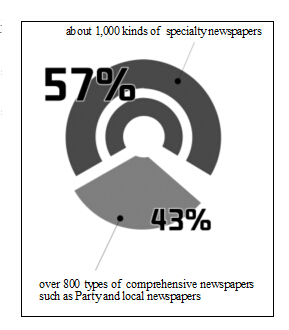In recent years, profound changes have taken place in China's media sector — competition is ever fiercer, traditional media face severe challenges, and the integrated development of traditional and new media is both an aspiration and a trend.
Traditional media are confronted by a range of competitive threats. According to a report published by Tsinghua University in May 2015 — the Development Report of China's Traditional Media (2015) — the daily circulation of newspapers among urban residents decreased from 53.5% in 2013 to 45.5% in 2014, and TV penetration declined from 82.2% to 78.8%, while web video watching rose from 18.7% in 2012 to 53.8% in 2014. Statistics from CTR market research indicate that, in the first half of 2015, newspaper advertising expenditure and space shrunk by 32.1% and 33.9% respectively, and TV advertising decreased by 3.4% in spending and by 10% in numbers year on year. In 2014, more than 30 newspapers ceased publication or went broke. In contrast, advertising revenue on new media is soaring. According to Analysis International, China's internet advertising market in the second quarter of 2015 was worth RMB53.24 billion, a year-on-year increase of 42.7%, up 33.1% from the first quarter.
Media integration offers further space for the transition of traditional media. On August 18, 2014, CPC General Secretary Xi Jinping presided over and made a speech at the fourth conference of the leading group for deepen all-round reform. At the conference, Directives on Boosting Integrated Development of Traditional and New Media was reviewed and approved as a strategy and action guide to media integration work in the new situation. In proceeding with this work, media agencies apply the latest information communication technology, fully integrate resources, create new communication platforms and terminals, explore news release and dissemination modes that meet the demands of the new situation, and innovate the whole process through news collecting and editing and all the way to release so as to build an omni-media platform. In today's China, almost all traditional media are merging into the new media sector, initially bringing into being a modern communication system with a variety of forms and platforms.
I. Newspapers, Periodicals and News Agencies
Currently, China's newspaper market is dominated firstly by Party newspapers and journals and then by periodicals and newspapers featuring articles on local news, different industries, lifestyle, and entertainment, forming a content-rich, well-structured, prosperous and modern newspaper publication network.

1. Profile of newspapers and periodicals. By the end of 2014, published on the mainland of China were 1,912 newspapers, among which there were more than 800 (43% of the total) Party and local urban newspapers, and about 1,000 (57%) specialty newspapers. In 2014, the total print runs of newspapers nationwide were 46.39 billion, down 1.85 billion (or 3.8%) from 2013; the total of printed pages was 192.23 billion, a decrease of 17.55 billion (or 8.4%) from 2013. Three newspapers dropped out of the average-one-million-print list. The operating revenues from newspaper publication hit RMB69.78 billion, down by 10.2% (or RMB7.88 billion). The total profit was RMB7.64 billion, a reduction of RMB1.12 billion (or 12.8%). The prime operating revenues and total profits from 46 newspaper and periodical publication groups fell by 1% and 16% respectively. Of them, 17 press groups fell into deficit, two more than in 2013. By the end of 2014, published altogether on the mainland of China were 9,966 different periodicals covering natural sciences, technology,philosophy, social science, culture, education, literature, arts, etc. In 2014, the total prints of periodicals were 3.1 billion, down 5.4% from 2013; the total number of printed pages was 18.36 billion, a drop of 5.7%; and the total pricing was RMB24.94 billion, a fall of 1.6%. In 2014, the operating revenues from periodical publication were RMB21.2 billion, 4.5% less than 2013; value added was RMB16.8 billion, down 0.4%; and total profits reached RMB2.71 billion, a fall of 5.4%.
